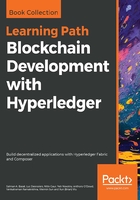
Strengths and advantages of a componentized design
Hyperledger Fabric's component design offers several advantages. Many of these strengths relate to business network governance, which is an important compliance and costs consideration for Hyperledger Fabric in the enterprise.
These benefits include the following:
- Delineates development design from runtime design: Separating development and runtime design is important because the delineation is important from development best practices and infrastructure/hybrid cloud variations, and ensuring adherence to the current enterprise and their connectivity to the business network's application development, as well as DevOps practices.
- Discerning between design imperatives and infrastructure/deployment capabilities: Componentized design allows us to separate infrastructure design, which includes things such as network connections, security, permissioning, and contractual vehicles, from the overall application design of the business network blueprint that dictates the technology blueprint.
- Incorporates network design principles: The modularity of Hyperledger Fabric can address infrastructure scaling issues, such as the number of connections, co-location, security, container deployment practices, and so on. There are various considerations when it comes to network design, such as cloud deployment, hybrid and/or on premises, and a combination of any of the available options, which are dependent on the requirements of individual members in a business network. Network design also addresses the business challenges of network growth and the resulting performance and security driven Service Level Agreements (SLA) to its members.
- Addresses channel design principles: Modularity, or componentized design, can also address isolation, data privacy, and confidentiality between participants and controlled/permissioned access with robust audit capability. Channel constructs in Hyperledger Fabric enable us to address the business blueprint requirements around implementing business-defined transactions that may be bilateral, trilateral, or event multilateral. Channels also provide an avenue to limit the visibility of transaction data to a few participants or provide full access when required, such as to a regulator. Channel design also addresses critical business requirements around transaction processing, data visibility, business rules enforcement, and so on. It also has technology implications, such as a scalability, security, and the costs of the infrastructure that supports the business network. Finally, channel design addresses the business challenges of network growth and the resulting performance and security-driven SLAs to members.
- Adopts Hyperledger Fabric composer model-driven development: Hyperledger Composer, one of the tools discussed previously under Hyperledger tools, provides an avenue to modular development with a portable, standardized vehicle to add governance and control, similar to JEE constructs such as JAR/WAR/RAR, and so on. Business network archive (BNA) is an archive that can be integrated into DevOps practices for cross-enterprise team development and collaborative life cycle management capabilities. The idea is to separate chaincode development from infrastructure design and separate the competencies needed to maintain the two facets of enterprise or business network application technology practices. More details around Hyperledger Fabric composer will be discussed in a separate chapter dedicated to the composer and tooling.
Each of the advantages of componentized design described previously have cost implications in terms of runtime/infrastructure design (that is, use of resources and resulting costs), flexible design (such as products and relationships morphs), and the longevity of the solution (the global footprint of the enterprise cloud infrastructure, including robust access to technical and business SMEs in the form of maintenance and support)—all of which are essential for compliance, governance, and longevity of the solution, and resulting business networks powered by blockchain.